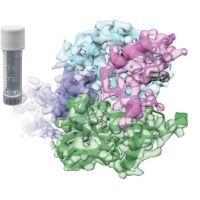Specification
| Description | Recombinant protein from the full-length sequence of homo sapiens phospholipid transfer protein (PLTP), transcript variant 1 (NM_006227). |
| Organism | Homo sapiens (Human) |
| Expression Host | Human Cells |
| Tag Info | His or DYKDDDDK. Please contact us if you need further information or require specific designed tag. |
| Purity | Greater than 90% by SDS-PAGE gel |
| Uniprot ID | P55058 |
| Entry Name | PLTP_HUMAN |
| Gene Names | PLTP |
| Alternative Gene Names | |
| Alternative Protein Names | Phospholipid transfer protein (Lipid transfer protein II) |
| Application | Antigens, Western, ELISA and other in vitro binding or in vivo functional assays, and protein-protein interaction studies; For research & development use only! |
| Buffer | Purified protein formulated in a sterile solution of PBS buffer, pH7.2, without any preservatives |
| Endotoxin | Endotoxin level is < 0.1 ng/µg of protein (<1EU /µg) |
| Length | 493 |
| Molecular Weight(Da) | 54739 |
| Protein Sequence | (The sequence of expressed protein may have some variation from the sequence shown below. Please contact us for the exact sequence.) MALFGALFLALLAGAHAEFPGCKIRVTSKALELVKQEGLRFLEQELETITIPDLRGKEGHFYYNISEVKVTELQLTSSELDFQPQQELMLQITNASLGLRFRRQLLYWFFYDGGYINASAEGVSIRTGLELSRDPAGRMKVSNVSCQASVSRMHAAFGGTFKKVYDFLSTFITSGMRFLLNQQICPVLYHAGTVLLNSLLDTVPVRSSVDELVGIDYSLMKDPVASTSNLDMDFRGAFFPLTERNWSLPNRAVEPQLQEEERMVYVAFSEFFFDSAMESYFRAGALQLLLVGDKVPHDLDMLLRATYFGSIVLLSPAVIDSPLKLELRVLAPPRCTIKPSGTTISVTASVTIALVPPDQPEVQLSSMTMDARLSAKMALRGKALRTQLDLRRFRIYSNHSALESLALIPLQAPLKTMLQIGVMPMLNERTWRGVQIPLPEGINFVHEVVTNHAGFLTIGADLHFAKGLREVIEKNRPADVRASTAPTPSTAAV |
Background
| Function | FUNCTION: Mediates the transfer of phospholipids and free cholesterol from triglyceride-rich lipoproteins (low density lipoproteins or LDL and very low density lipoproteins or VLDL) into high-density lipoproteins (HDL) as well as the exchange of phospholipids between triglyceride-rich lipoproteins themselves (PubMed:7654777, PubMed:9132017, PubMed:11013307, PubMed:19321130, PubMed:21515415, PubMed:29883800). Facilitates the transfer of a spectrum of different lipid molecules, including diacylglycerol, phosphatidic acid, sphingomyelin, phosphatidylcholine, phosphatidylinositol, phosphatidylglycerol, cerebroside and phosphatidyl ethanolamine (PubMed:9132017). Plays an important role in HDL remodeling which involves modulating the size and composition of HDL (PubMed:29883800). Also plays a key role in the uptake of cholesterol from peripheral cells and tissues that is subsequently transported to the liver for degradation and excretion (PubMed:21736953). Two distinct forms of PLTP exist in plasma: an active form that can transfer phosphatidylcholine from phospholipid vesicles to HDL, and an inactive form that lacks this capability (PubMed:11013307). {ECO:0000269|PubMed:11013307, ECO:0000269|PubMed:19321130, ECO:0000269|PubMed:21515415, ECO:0000269|PubMed:29883800, ECO:0000269|PubMed:7654777, ECO:0000269|PubMed:9132017, ECO:0000303|PubMed:21736953}. |
| Pathway | |
| Protein Families | BPI/LBP/Plunc superfamily, BPI/LBP family |
| Tissue Specificity | Widely expressed. Highest level of expression in the ovary, thymus and placenta, with moderate levels found in the pancreas, small intestine, testis, lung and prostrate. Low level expression in the kidney, liver and spleen, with very low levels found in the heart, colon, skeletal muscle, leukocytes and brain. Expressed in the cortical neurons. {ECO:0000269|PubMed:19321130, ECO:0000269|PubMed:7654777}. |
QC Data
| Note | Please contact us for QC Data |
| Product Image (Reference Only) |  |

